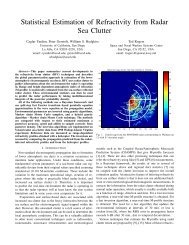Statistical Estimation and Tracking of Refractivity from Radar Clutter
Statistical Estimation and Tracking of Refractivity from Radar Clutter
Statistical Estimation and Tracking of Refractivity from Radar Clutter
Create successful ePaper yourself
Turn your PDF publications into a flip-book with our unique Google optimized e-Paper software.
3<br />
agation calculations. Due to the curvature <strong>of</strong> the Earth, an initially horizontally<br />
propagating signal will be moving away <strong>from</strong> the surface. To take this effect into<br />
account, the modified refractivity (M) has been introduced. N <strong>and</strong> M can be<br />
computed as<br />
N = (n − 1) × 10 6 = 77.6p<br />
T<br />
rh6.105 expx<br />
e s =<br />
100<br />
x = 25.22 T − 273.2<br />
T<br />
+ e s3.73 × 10 5<br />
T 2 (1.1)<br />
( ) T<br />
− 5.31 log e<br />
273.2<br />
(1.2)<br />
(1.3)<br />
M = N + h a × 106 (1.4)<br />
M ≃ N + 0.157h, (1.5)<br />
where e s is the partial pressure <strong>of</strong> water vapor, p is the barometric pressure in<br />
millibars, T is the temperature in o K, rh is the percent relative humidity, h is the<br />
height above the earth’s surface, <strong>and</strong> a is the radius <strong>of</strong> the Earth.<br />
Classification <strong>of</strong> Atmospheric Conditions<br />
Even though the fluctuations are on the order <strong>of</strong> part-per-millions, they<br />
are sufficient to cause major changes in the tropospheric electromagnetic propagation.<br />
Normally, the refractivity is a near-exponential function <strong>of</strong> the altitude. This<br />
exponential can be linearized within the first kilometer or so <strong>of</strong> the atmosphere.<br />
The slope <strong>of</strong> this linear function is –0.039 N-units/m or 0.118 M-units/m <strong>and</strong> it<br />
usually is referred to as the “st<strong>and</strong>ard atmosphere”. St<strong>and</strong>ard atmosphere will<br />
result in a downward bending <strong>of</strong> the electromagnetic wave. However, this is less<br />
than the curvature <strong>of</strong> the earth, effectively resulting in a wave that slowly moves<br />
away <strong>from</strong> the surface. This type <strong>of</strong> propagation is called the normal propagation<br />
condition <strong>and</strong> it occurs as long as N is between –0.079 to 0 N-units/m (0.079 to<br />
0.157 M-units/m).<br />
If N has a positive slope with respect to the altitude, the wave will further<br />
bend upward creating the sub-refractive conditions, which only infrequently occurs




